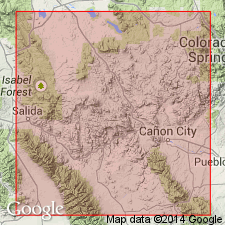
- Usage in publication:
-
- High Park lake beds*
- Modifications:
-
- Original reference
- Dominant lithology:
-
- Sandstone
- Conglomerate
- AAPG geologic province:
-
- Denver basin
Summary:
High Park lake beds. Remnants of a series of local sandstones and conglomerates lying either on granite or on a thin rhyolite flow, the conglomerates characterized by pebbles of extremely hard Algonkian quartzite, granite, and gneiss. No fossils; but beds appear to be older than adjacent volcanic breccia, which in many places rests on Florissant lake beds. Is older than Alnwick lake beds. [USGS adopted (ca. 1938) Tertiary (late Miocene or Pliocene) age for this unit.]
Named from High Park, Pikes Peak region, eastern CO.
Source: US geologic names lexicon (USGS Bull. 896, p. 955).

- Usage in publication:
-
- High Park Lake Beds†
- Modifications:
-
- Abandoned
Summary:
Abandoned. Rocks formerly assigned to Alnwick and High Park Lake Beds in the southeast corner of the Florissant quad and northeast quarter of Cover Mountain quad, Teller and Fremont Cos, CO, Denver basin, are now included in the Tallahassee Creek Conglomerate (new).
Source: GNU records (USGS DDS-6; Denver GNULEX).
For more information, please contact Nancy Stamm, Geologic Names Committee Secretary.
Asterisk (*) indicates published by U.S. Geological Survey authors.
"No current usage" (†) implies that a name has been abandoned or has fallen into disuse. Former usage and, if known, replacement name given in parentheses ( ).
Slash (/) indicates name conflicts with nomenclatural guidelines (CSN, 1933; ACSN, 1961, 1970; NACSN, 1983, 2005, 2021). May be explained within brackets ([ ]).

